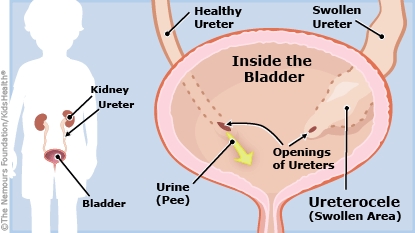Ureterocele: How to Care for Your Child
Each ureterocele is different, but surgery is typically recommended to repair this birth defect.


Urine is made in the kidneys and normally flows down through tubes called ureters to the bladder, where it is stored until a person urinates (pees). The urine then flows out of the body through another tube called the urethra.
A ureterocele is a swollen area where one of the ureters connects to the bladder. The swelling can be completely inside the bladder or it may go into the urethra. The swelling may slow or block the flow of urine from the ureter to the bladder and out of the body. Urine may back up into the kidney.
Kids with ureteroceles are more likely to get urinary tract infections (UTIs). Some kids with ureteroceles have no symptoms, while others have trouble urinating, growth problems, blood in the urine, or occasional belly pain.
The health care provider asked you questions and examined your child. An ultrasound study was ordered and showed the ureterocele.
Surgery can fix the problem. The surgeon may shrink or remove the ureterocele, and may change the way that the ureter connects to the bladder. In a few kids, the kidney that the involved ureter is attached to doesn't work properly. If this is the case, the surgeon may remove any damaged kidney tissue.
Your health care provider may prescribe a daily low dose of antibiotics to prevent UTIs.



Your child:
-
Begins peeing frequently.
-
Has pain with urination.
-
Has foul-smelling, bloody, or cloudy urine.
-
Has pain in the lower back or belly.
-
Has a fever.
-
Is an infant and is feeding poorly or is unusually irritable.
-
Is vomiting.
-
Is constipated.

Your child:
-
Has a high fever with shaking, chills, back pain, nausea, or pain during urination.
-
Is unable to urinate.